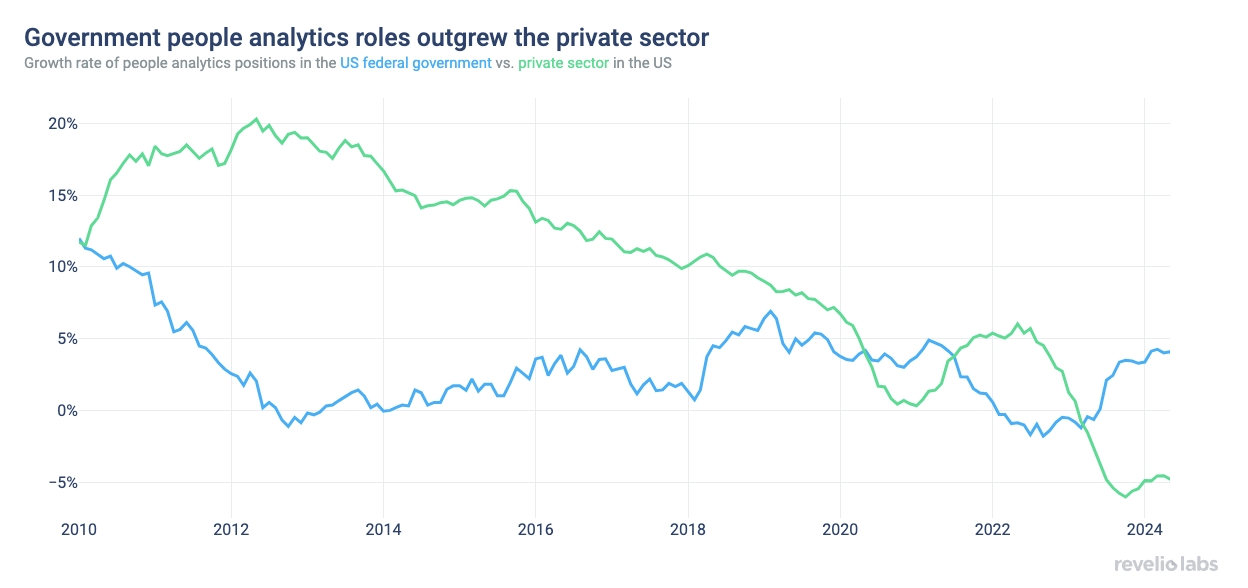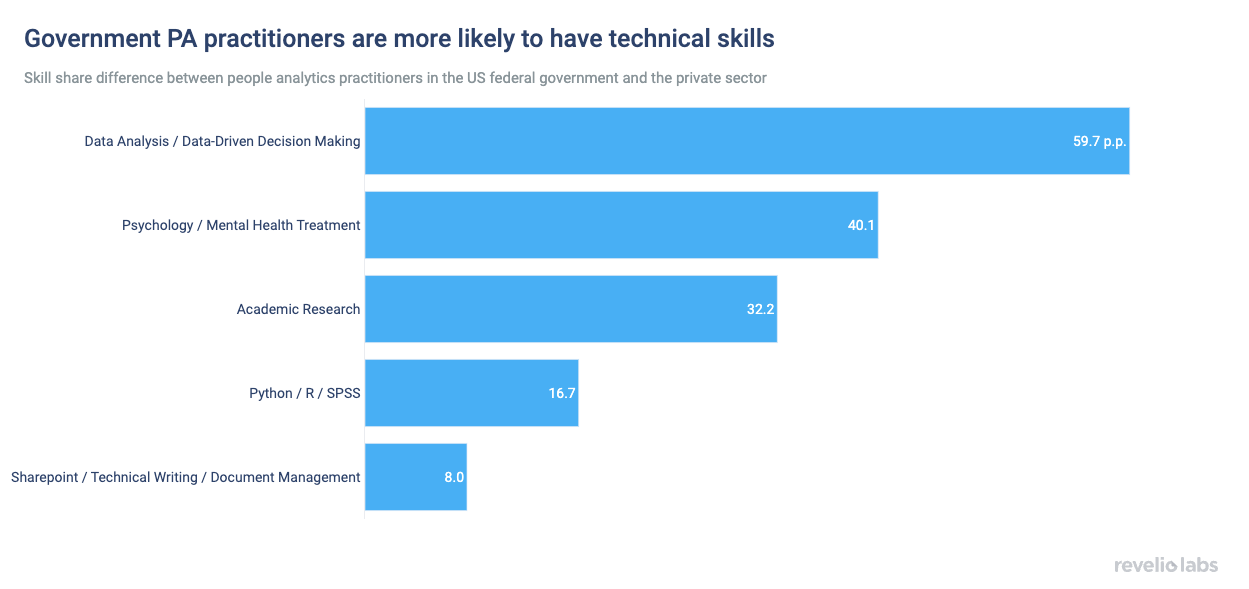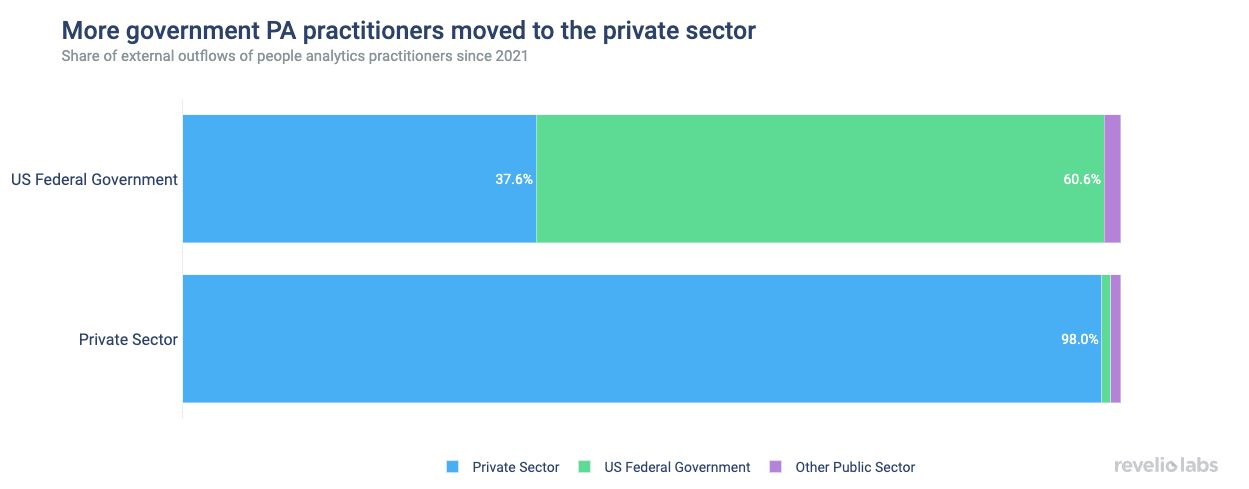This Is Where People Analytics Is a ‘Must-Have’ Rather Than a ‘Nice-To-Have’
Analytics of the people, by the people, for the people

People analytics roles in the federal government have recently grown at modest but stable rates, reflecting budget stability and a focus on data-driven workforce planning, even as private sector demand has declined amid rising interest rates.
Federal government people analytics practitioners are more likely to hold advanced degrees, supporting the public sector’s focus on long-term, research-intensive projects, unlike the private sector’s focus on immediate ROI.
People analytics practitioners in government rely heavily on advanced technical skills, such as data analysis and interdisciplinary research, due to the focus on regulatory compliance and large-scale data-driven decision-making.
Examining the history and foundations of people analytics reveals that its roots lay in fields like applied social psychology, sociology, and industrial-organizational psychology. Many early psychological experiments took place in federal settings, such as the U.S. Army’s Alpha and Beta aptitude tests developed during World War I. While the formal title "People Analytics" is relatively recent, the federal government has long had roles that rely on core people analytics principles. Public and private sector roles are shaped by distinct market conditions: Private sector roles respond to market dynamics, whereas public sector roles depend on approved federal funding. Consequently, people analytics roles in government often show trends that differ from those in the profit-driven private sector. Motivated by our previous newsletter on people analytics positions in the private sector, and in collaboration with Cole Napper and Kristin Saboe, we explore the evolution of people analytics roles within the U.S. federal government and draw comparisons to trends in the private sector.
Using Revelio Labs’ HR data, we analyze U.S. federal government positions with titles containing keywords like Operations Research and Systems Analyst (ORSA), Research Psychologist, Personnel Psychologist, Personnel Analyst, Human Performance Research, Personnel Research, and Industrial and Organizational (I/O) Psychologist. In total, we identify approximately 2,100 people analytics roles within the U.S. federal government in 2024. While the private sector saw a 20% growth in people analytics positions around 2012, the federal government’s growth was more subdued, plateauing with minimal change.


However, recent economic shifts reveal an interesting dynamic. As interest rates rose and the labor market cooled, the private sector curbed its expansion of people analytics roles, and in the past year has decreased the size of the people analytics workforce. In contrast, the federal government saw a modest increase in these roles, driven by the stability of public sector budgets and the need for data-driven strategies to address workforce planning in a tighter job market. This uptick aligns with broader economic conditions: As businesses pull back on hiring amid rising costs, government jobs gain appeal due to their stability, thus increasing people analytics opportunities within federal agencies.
Sign up for our newsletter
Our weekly data driven newsletter provides in-depth analysis of workforce trends and news, delivered straight to your inbox!
When comparing the educational backgrounds of people analytics practitioners in the private sector to the federal government, we find that federal employees are more likely to hold advanced degrees. This difference likely reflects the public sector’s significant investment in applied research and analytics, where the focus on long-term projects and foundational knowledge often necessitates highly educated talent with advanced skills. In contrast, private sector roles may face budgetary constraints that limit true exploratory research, with a stronger emphasis on immediate ROI and operational efficiencies.


Highly educated people analytics professionals in the federal government bring advanced technical skills, with data analysis, Python, and research being notably more common among federal practitioners. Specifically, the proportion of people analytics professionals with data analysis skills is 61.5 percentage points higher in the federal government than in the private sector. The overrepresentation of technical skills reflects the nature of government work, which often involves large-scale data collection and analysis for population-wide insights and program evaluation. In contrast, private sector roles may focus more on operational efficiencies and immediate business needs, with fewer opportunities for the advanced data handling required in the public sector.


The daily activities of U.S. federal government people analytics practitioners show a distinct focus on technically demanding tasks. Government roles frequently involve data analysis and reporting for regulatory compliance, as well as interdisciplinary research and complex data analysis—activities that require advanced technical skills. This focus reflects the unique demands of federal roles, where compliance, transparency, and policy-driven insights are critical. Government practitioners handle large datasets to support regulatory requirements and program evaluation, reinforcing the need for strong technical expertise to inform broad, impactful decisions.


The technical skills of people analytics practitioners in the federal government make them highly attractive to the private sector. Since 2021, over a third of public sector professionals have transitioned to private sector roles, whereas private sector practitioners predominantly stay within the private sector.


This talent flow aligns with the differing skill and task requirements between sectors. Government roles often cultivate a strong foundation in technical and research-intensive skills, which are increasingly valuable in the private sector as businesses seek more data-driven decision-making capabilities. Meanwhile, the private sector’s emphasis on operational efficiency and talent optimization encourages retention within the industry, as these skills directly match its needs. This flow demonstrates a natural talent exchange, where public sector experience provides transferable analytical expertise, while the private sector offers continuity for those focused on strategic HR and efficiency-driven tasks.

